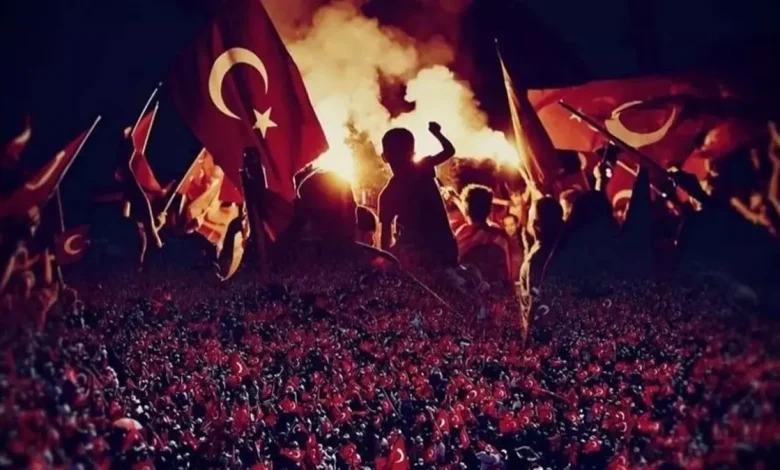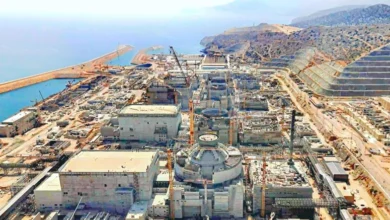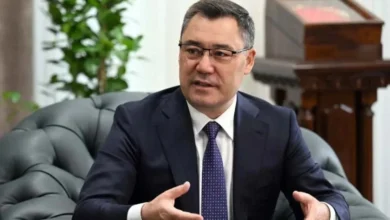
It has been seven years since the resistance of July 15, 2016, when the Turkish nation braved bombs and bullets to prevent a bloody coup attempt by the Fetullah Terrorist Organization (FETO), Turanews.kz reports citing Anadolu Agency.
Seeking to infiltrate the Turkish state since it was founded, FETO attempted a coup on the night of July 15, exposing its unlawful acts it had committed under the guise of a religious community.
After the Justice and Development (AK) Party came to power with 49% of the votes in general elections on Nov. 1, 2015, FETO was shaken by a decision by prosecutors in the western province of Izmir to arrest soldiers affiliated with the terror group.
The terror group decided to stage the coup once it realized that its schemes would not be enough to reverse the move, including by summoning then-Undersecretary of the National Intelligence Organization (MIT) Hakan Fidan and other senior officials for questioning, a large-scale raid on Dec. 17-25, 2013 to detain prominent government figures, and stopping MIT trucks near the Syrian border in 2014.
A recorded speech by US-based FETO ringleader Fethullah Gulen on March 19, 2016, was identified as a call for the putsch.

Following Gulen’s orders, civilian and military members of the terror group went into action as they completed preparations for the coup attempt across Türkiye.
Bulent Aydin, the bodyguard of then-Land Forces Commander Salih Zeki Colak, was killed by the putschists at the General Staff Headquarters. Aydin was recorded as the first to be killed in the coup attempt.
First investigation into coup attempt
F-16 jets took off from the Akinci Air Base — used as a command center during the coup bid — and began flying at low altitudes over the capital Ankara.
The first news reports of movement by the forces at the base emerged at 10.28 p.m. local time (1928GMT). TV channels were covering developments as breaking news, reporting that troops were blocking the Bosphorus Bridge and Fatih Sultan Mehmet Bridge, both of which span the Istanbul Strait.
Then-Prime Minister Binali Yildirim, at 11.02 p.m. called private broadcaster NTV on the phone and said: “The government, representing the people, is in charge. Those who attempted this coup, those who engaged in this madness, those involved in this illegal action will pay the heaviest price.”
The Ankara Chief Public Prosecutor’s Office launched an investigation into the coup attempt at 11.05 p.m.
Crucial institutions shelled
The coup plotters attacked the Aviation Department of the General Directorate of Security in the Golbasi district of Ankara, followed by an attack on the Police Special Operations Department.
Additionally, helicopters under the control of the putschists targeted the MIT compound in Yenimahalle district of the capital.
At the building of public broadcaster TRT, the putscist soldiers forced an anchorwoman to read out the coup statement on air.
Igniting spark of resistance
Speaking to CNN Turk, another private news channel, at 12.24 a.m., President Recep Tayyip Erdogan delivered a historic speech that night, changing the course of the coup attempt and calling on Turkish people to take to the streets in order to stop the putschists.
During the resistance against the coup perpetrators in front of the Gendarmerie General Command Headquarters, helicopter gunfire resulted in the deaths of nine people and injured dozens.
At 12.56 a.m., two putschist pilots used their F-16 jets to target the Police Headquarters in Ankara, followed by a second bombing about 10 minutes later at the same location.
Coup-plotter commander slain
Special Forces Group Commander Brig. Gen. Semih Terzi’s plane from Diyarbakir landed in Ankara at the Etimesgut Air Base at 1.13 a.m.
Learning that Terzi, commander of the 1st Special Forces Brigade in southeastern Sirnak province, was assigned by the coup plotters to take over the his unit, Maj. Gen. Zekai Aksakalli, then-commander of the Special Forces Command, lost no time in ordering his right-hand man Omer Halisdemir by phone to kill Terzi in order to abort their plan.
When Terzi attempted to seize control, Halisdemir shot and killed him but was gunned down by the pro-coup general’s accompanying FETO-affiliated soldiers.
Halisdemir has since became a beacon of the resistance against the defeated coup.
Parliament shelled
Three dozen civilians resisting the coup attempt were killed in front of the General Staff Headquarters in Ankara.
Resorting to every means to break their will to fight back, the coup plotters targeted the country’s parliament, with FETO-affiliated pilots dropping bombs on the building, injuring 32.
TRT was liberated from the putschists at 3 a.m., returning to normal broadcasting as the coup plotters were handed over to police.
A FETO-member pilot also bombed the facility of the facilities of Turkish satellite operator Turksat four times between 3.14 a.m. and 3.19 a.m. in a bid to disrupt television broadcasts.
Coup plotters who occupied the control tower of Istanbul Ataturk Airport were later “neutralized” by police special forces, and, shortly thereafter, the plane carrying President Erdogan touched down on the runway. Thousands welcomed Erdogan at the airport.
Following developments in Istanbul, parliament once again came under the attack of a putschist pilot, who bombed the legislature for a second time at 3.24 a.m. and 3.25 a.m. in an F-16 aircraft.
At 4 a.m., the Ankara Chief Public Prosecutor’s Office issued arrest warrants for judicial officials affiliated with FETO and other members of the terror group involved in the coup attempt, including the so-called “Peace at Home Council” sub-group, which was meant to replace the government had the deadly putsch not been defeated.
End of the road for the coup plotters
At 6.19 a.m., another FETO-member fighter pilot dropped two bombs from on the road in front of the presidential complex in Ankara. In the attack, 15 people were killed and seven injured.
Then-Counter Terrorism Department head Turgut Aslan, who was withheld at the Gendarmerie General Command, and his bodyguard Hasan Gulhan, with their hands and eyes tied, were taken out of the building and shot in the head by a putschist colonel. Aslan was seriously injured, while Gulhan died.
Prime Minister Yildirim authorized Lt. Gen. Ziya Kemal Kadioglu to shoot down aircraft piloted by the coup plotters, with Kadioglu conveying the orders to pilots based in the country’s east and south.
The coup plotters at the Bosphorus Bridge surrendered when they realized that their attempt to seize power had failed.
At 8.26 a.m., then-Chief of Staff Hulusi Akar, who was being held by the coup plotters, was taken from Akinci Base to the Cankaya Palace in Ankara by helicopter.
Upon the orders of President Erdogan and then-National Defense Minister Fikri Isik, the main runway of the Akinci Base was targeted to prevent the putschists’ aircraft from taking off.
At 12.57 p.m., Yildirim, Isik, and Akar announced at a press conference at the Cankaya Palace that the coup attempt had been defeated.
Thus, thanks to President Erdogan’s leadership, the efforts of the Turkish nation and security forces, the coup attempt was beaten in about 21 hours, with records showing that about 9,000 military personnel, 35 planes, 37 helicopters, 74 tanks, 246 armored vehicles, and nearly 4,000 light weapons were used by the putschists.



